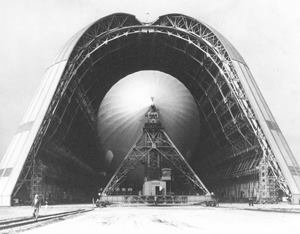Although the 785-foot-long rigid-frame airship USS Macon crashed into the ocean in 1935, less than two years after its first flight, its monumental home has remained as an emblem of Machine Age exuberance. Yet even with its storied past, Hangar One at Moffett Field, just south of San Francisco, has an uncertain future.
Designed by Karl Arnstein and completed in 1933, “it is one of the few artifacts we have left from the era of great rigid airships,” says Bill Stubkjaer, curator of the Moffett Field Historical Society Museum. In 2003, the environmental contaminant Aroclor was traced to the hangar’s corrugated steel exterior panels, known as Galbestos. Runoff was carrying toxic polychlorinated biphenyls (PCBs) from the coating of asphalt-saturated asbestos felt into San Francisco Bay. The Navy sealed the panels with a temporary asphalt clear coat and, in 2006, announced plans to demolish the building. Determined to find a long-term solution that would meet both environmental and historical interests, a group of ex-Navy personnel and preservation advocates united to explore alternatives to demolition. Community members put aside debates about the future of Moffett Field to form the Save Hangar One Committee (savehangarone.org). Founding member Steve Williams, a pilot from the Bay Area, recalls the sense of romance, mystery, and awe the structure inspired in him as a child. The hangar’s 198-foot-tall “orange-peel” doors and 1,133-foot length dwarfed everything in the surrounding landscape save the Golden Gate Bridge. Williams now views the hangar as a precursor to the Northern California “technology culture” epitomized by Silicon Valley.
As of a community meeting held early last month, the Navy had narrowed 13 possible options down to five: applying an acrylic coating or a rubberized material over the existing siding; replacing the siding; removing the siding and coating the exposed structure; or demolishing the hangar. The Navy will not make a final decision until it concludes a structural analysis, drafts a revised engineering evaluation/cost analysis, and receives public comments. If the hangar is preserved, NASA—which has owned the airfield since 1994—will control any potential future uses.
